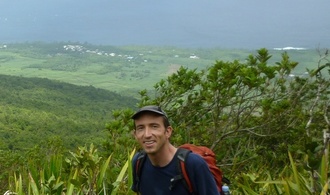The islands as "model systems" for research in ecology and evolution
Written by Modified on the
Ben Warren, former biologist with the PVBMT Joint Research Unit (CIRAD - University of Reunion Island) and now based at the University of Zurich, recently published in Ecology Letters[1] an article commemorating the 50th anniversary of a fundamental biological study: MacArthur and Wilson’s Theory of Island Biogeography, published in 1963.
In collaboration with an international working group funded by the Foundation for Research on Biodiversity ( FRB)[2], Ben Warren and his colleagues will examine the potential of using the approach proposed by MacArthur and Wilson, i.e. using the islands as a model to better understand general ecological and evolutionary processes around the world.
Interview with Ben Warren:
Bio&Agri - Your article is published the day after the 50th anniversary of the publication of MacArthur & Wilson’s theory. Can you explain their theory ?
Ben Warren - The theory of MacArthur and Wilson explains that the number of species on an island results from a balance between immigration of new species and the extinction of species present. According to them, the species richness of an island depends on its size and isolation or remoteness from mainland. The two scientists were able to use islands as "tools" to quantify the effects of size and isolation of a geographic region on its biodiversity.
B&A - To what extent are islands now "model systems" in ecology and evolution ?
BW - Since 1963, island systems have provided new insights into our understanding of the ecology and evolution of communities in general, including areas beyond the islands. Coasts act as a natural border, existing for millennia, for natural distributions of species and populations. The identification of current and historical distributions of species and populations is thereby made possible. Much research is also often impossible to repeat in the laboratory or during the timeframe of a human life. Furthermore, islands are often used as "virgin" land areas to study the formation of natural communities (forests, savannas, etc.), having been formed devoid of all life as a result of volcanic activity (e.g. The Mascarenes in the Indian Ocean) or resulting from phenomena linked to changes in oceans level (e.g. Aldabra and the Scattered Islands, Indian Ocean). The islands thus offer several advantages and unusual opportunities for research, and the findings are applied worldwide.
B&A - You use molecular and data acquisition tools that were unavailable in the 1960s. How have these tools helped you to take MacArthur & Wilson’s theory further ?
BW - Today’s molecular and data acquisition tools allow us to achieve a more accurate answer to certain fundamental questions posed by MacArthur and Wilson. These authors studied the effects of size and isolation of a geographical region on the ease with which organisms arrive (natural immigration) and how they resist local extinction. Since then, it was observed that the number of species in a given geographical area tended to increase thanks to the division of certain populations in two or several distinct species. This is an evolutionary process, called speciation, at the origin of new species. Now, molecular techniques allow us to highlight speciation and reveal its significance in geographical regions of varying sizes, ages and isolation, the study of which helps refine our understanding of the phenomenon of speciation itself.
[1] Islands as model systems in ecology and evolution: prospects fifty years after MacArthur-Wilson - Ecology Letters (2015) 18: 200–217.
[2] At the Centre for the Synthesis and Analysis of Biodiversity - CESAB (Aix-en-Provence).
